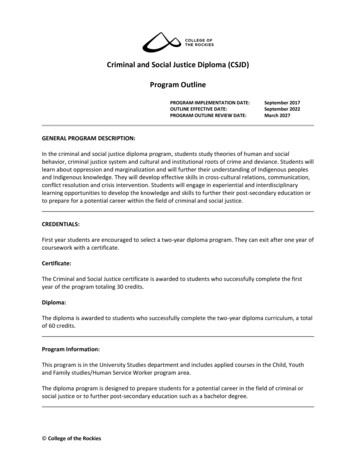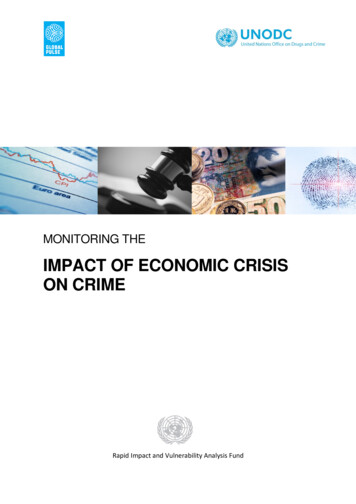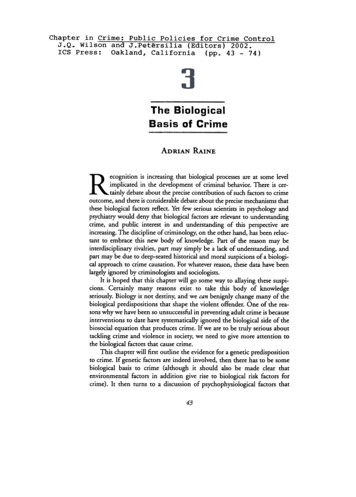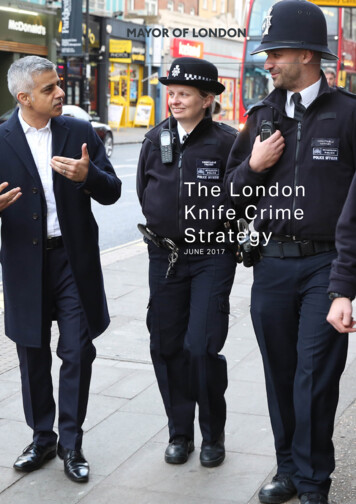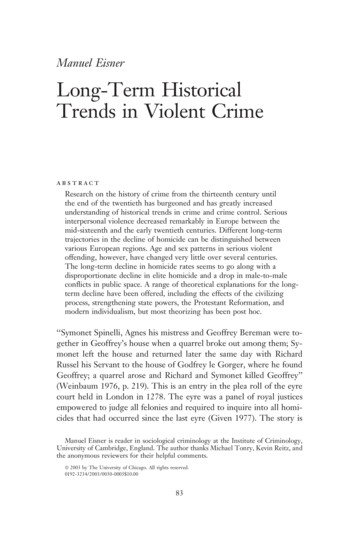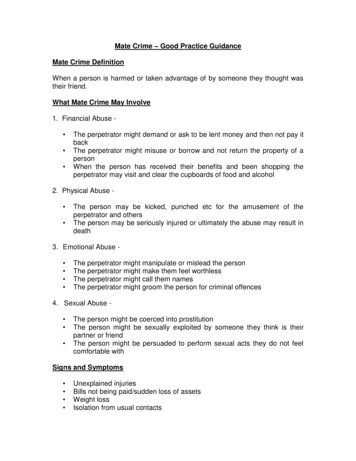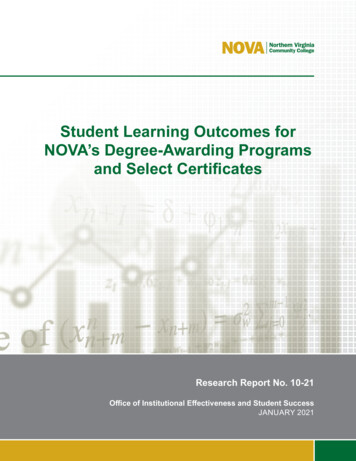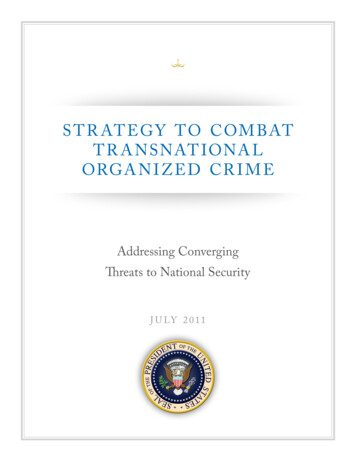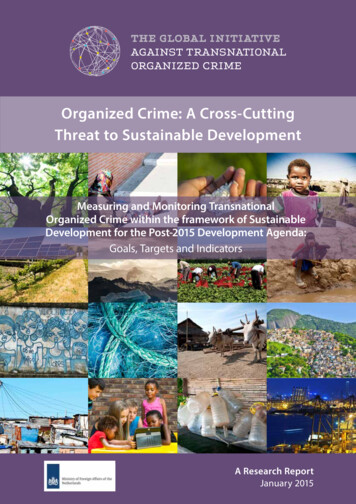
Transcription
Organized Crime: A Cross-CuttingThreat to Sustainable DevelopmentMeasuring and Monitoring TransnationalOrganized Crime within the framework of SustainableDevelopment for the Post-2015 Development Agenda:Goals, Targets and IndicatorsA Research ReportJanuary 2015
A NETWORKTO COUNTERNETWORKS
Organized Crime:A Cross-Cutting Threat toSustainable DevelopmentMeasuring and Monitoring Transnational Organized Crime withinthe framework of Sustainable Development for thePost-2015 Development Agenda:Goals, Targets and IndicatorsJanuary 2015
TWA NEORKTO CEROUNTNETWORKSAppreciation and AcknowledgementsThis report note was drafted by a team from the Global Initiative Secretariat, comprising Tuesday Reitano,Marcena Hunter, Adam Rodriques and Mark Shaw.The greatest thanks go to our close collaborators at Saferworld, Thomas Wheeler, Larry Atree and Anna MöllerLoswick for the generous sharing of their time and expertise. Thanks also to Claudia Seymour of Small ArmsSurvey for advice and guidance.The team drew heavily on the expertise of the Global Initiative Network of Experts, and in particular would liketo acknowledge the contribution of Richard Byrne of Harper Adams University; Wietse Van der Werf of the BlackFish organisation, and Robert McLaughlin of the Australian National University.Layout of the report was done by Sharon Wilson of Emerge Creative, with free icons made by Freepik, StephenHutchings, Designerz Base, Icomoon, http://www.flaticon.com.The Global Initiative would like to thank the Government of the Netherlands, and in particular, Yaron Oppenheimer,for substantive and financial support. 2015 Global Initiative against Transnational Organized Crime. All rights reserved.No part of this publication may be reproduced or transmitted in any form or by any means without permissionin writing from the Global Initiative. Please direct inquiries to:The Global Initiative against Transnational Organized CrimeWMO Building, 2nd Floor7bis, Avenue de la PaixCH-1211 Geneva 1Switzerlandwww.GlobalInitiative.net
About the Global Initiative against Transnational Organized CrimeThe Global Initiative (www.globalinitiative.net) is a network of prominent law enforcement, governance anddevelopment practitioners who are dedicated to seeking new and innovative strategies and responses toorganized crime.Nature of the challengeThe problem of organised crime is not new, but the scope, scale and spread of the phenomena is now unprecedented.It affects all countries, developed, middle-income and developing, as well as states beset by political instability andconflict. The impacts can be diverse, but the common feature is that organised crime negatively affects the lifechances of ordinary people: it undercuts key institutions, damages the environment, distorts or impedes economicgrowth and it fuels conflict.While there is growing consensus as to the rapid evolution and detrimental impact of organized crime, there ismuch less agreement around what constitutes an effective response.Catalyzing a new approachThe Global Initiative was born from a series of high-level, off the record discussions between mainly (though notexclusively) law enforcement officials from both developed and developing countries, hosted by the InternationalPeace Institute in New York in 2011-12. At these meetings, the founding members of the Global Initiative, manyof whom stand at the front line of the fight against organised crime, illicit trafficking and trade, concluded thatthe problem and its impacts are not well analysed; they are not systematically integrated into national plans orstrategies; existing multilateral tools are not structured to facilitate a response and existing forms of cooperationtend to be bilateral, slow and restricted to a limited number of like-minded states.The result was a decision to create a new initiative: the Global Initiative against Transnational Organised Crime,which would seek to provide a platform to promote greater debate and innovative approaches as the buildingblocks to an inclusive global strategy against organised crime.Analysis, Strategies and ResponseLaunched formally in New York in September 2013, the Global Initiative comprises a growing network ofindependent global and regional experts working on human rights, democracy, governance and developmentissues where organised crime has become increasingly pertinent.The Global Initiative is an international civil society organisation, has an office in Geneva, Switzerland, a coreSecretariat and a high-level advisory board. Through a range of channels, the Global Initiative seeks to projectthe expertise of its Network members outwards and to make it available to a broader range of stakeholders.For more information please visit our website at www.globalinitiative.netor contact the Secretariat at: secretariat@globalinitiative.net.@GI TOC@GI TOC tionalOrganizedCrime
TWA NEORKTO CEROUNTNETWORKSTable of ContentsList of Proposed Sustainable Development Goals to be attained by 2030.1I. Introduction: Organised Crime as a Development Issue.3Organised crime: a spoiler to development.3Call for action from the development community.4New tools and analytical frameworks.6Objectives of the Report.7Responding to organised crime.8II. Addressing Organised Crime in Sustainable Development Goals.11Goals at Risk.11GOAL 3: Ensure healthy lives and promote well-being for all at all ages.12GOAL 14: Conserve and sustainably use the oceans, seas and marine resourcesfor sustainable development.16GOAL 15: Protect, restore and promote sustainable use of terrestrialecosystems, sustainably manage forests, combat desertification, and halt andreverse land degradation and halt biodiversity loss.19GOAL 16: Promote peaceful and inclusive societies for sustainabledevelopment, provide access to justice for all and build effective, accountableand inclusive institutions at all levels.22Targets at Risk.29GOAL 2: End hunger, achieve food security and improved nutrition, andpromote sustainable agriculture.30GOAL 5: Achieve gender equality and empower all women and girls.34GOAL 6: Ensure availability and sustainable management of water andsanitation for all.37GOAL 8: Promote sustained, inclusive and sustainable economic growth,full and productive employment and decent work for all.40GOAL 10: Reduce inequality within and among countries.44GOAL 11: Make cities and human settlements inclusive, safe, resilient andsustainable.48
Development Impacts at Risk.50GOAL 1: End poverty in all its forms everywhere.51GOAL 4: Ensure inclusive and equitable quality education and promotelife-long learning opportunities for all.53GOAL 7: Ensure access to affordable, reliable, sustainable, and modern energyfor all. 54GOAL 9: Build resilient infrastructure, promote inclusive and sustainableindustrialisation and foster innovation.55GOAL 12: Ensure sustainable consumption and production patterns.57GOAL 13: Take urgent action to combat climate change and its impacts.58GOAL 17: Strengthen the means of implementation and revitalise the globalpartnership for sustainable development.59Annex 1. Indicator Tables.61Goals at Risk.63Targets at Risk.72Endnotes and References.82Measuring and Monitoring Transnational Organised Crime Within the SDGsvii
TWA NEORKTO CEROUNTNETWORKSList of Proposed Sustainable Development Goals to beattained by 2030Goal 1:End poverty in all its forms everywhereGoal 2:End hunger, achieve food security and improved nutrition, and promote sustainableagricultureGoal 3:Ensure healthy lives and promote well-being for all at all agesGoal 4:Ensure inclusive and equitable quality education and promote life-long learningopportunities for allGoal 5:Achieve gender equality and empower all women and girlsGoal 6:Ensure availability and sustainable management of water and sanitation for allGoal 7:Ensure access to affordable, reliable, sustainable, and modern energy for allGoal 8:Promote sustained, inclusive and sustainable economic growth, full and productiveemployment and decent work for allGoal 9:Build resilient infrastructure, promote inclusive and sustainable industrialization andfoster innovationGoal 10:Reduce inequality within and among countriesGoal 11:Make cities and human settlements inclusive, safe, resilient and sustainableGoal 12:Ensure sustainable consumption and production patternsGoal 13:Take urgent action to combat climate change and its impactsGoal 14:Conserve and sustainably use the oceans, seas and marine resources for sustainabledevelopmentGoal 15:Goal 16:Goal 17:Protect, restore and promote sustainable use of terrestrial ecosystems, sustainablymanage forests, combat desertification, and halt and reverse land degradation andhalt biodiversity lossPromote peaceful and inclusive societies for sustainable development, provideaccess to justice for all and build effective, accountable and inclusive institutionsat all levelsStrengthen the means of implementation and revitalize the global partnership forsustainable development.1Measuring and Monitoring Transnational Organised Crime Within the SDGs
Acronyms and AbbreviationsATTArms Trade TreatyCITESConvention on International Trade in Endangered SpeciesEEZExclusive Economic ZoneFAOUnited Nations Food and Agricultural OrganisationFATFFinancial Action Task ForceGFIGlobal Financial IntegrityHLPHigh Level PanelILOInternational Labour OrganisationIMFInternational Monetary FundINCBInternational Narcotics Control BoardIOMInternational Organisation for MigrationIUUIllegal, Unreported, and Unregulated fishingNCMECUnited States National Centre for Missing and Exploited ChildrenNGONon-Governmental OrganisationOECDOrganisation for Economic Cooperation and DevelopmentOWGOpen Working GroupMDGsMillennium Development GoalsSDGsSustainable Development GoalsSMARTSpecific, Measureable, Achievable, Relevant, and Time-boundTOCTransnational Organised CrimeUNCACUnited Nations Convention against CorruptionUNCLOSUnited Nations Convention on the Law of the SeaUNDPUnited Nations Development ProgrammeUNEPUnited Nations Environment ProgrammeUNFPAUnited Nations Population FundUNODCUnited Nations Office on Drugs and CrimeUNTOCUnited Nations Convention on Transnational Organised CrimeWHOWorld Health OrganisationMeasuring and Monitoring Transnational Organised Crime Within the SDGs2
TWA NEORKTO CEROUNTNETWORKSOx cart at the riverside in Kyaikto city, Myanmar. Credit: topten22photoI. Introduction:Organised Crime as a Development IssueOrganised crime: a spoiler to developmentThe international community has become increasingly aware of the extent to which organised crime serves as aspoiler of sustainable development. This realisation has been enshrined in a number of seminal reports. In 2005,the report of the United Nations (UN) Secretary-General, “In Larger Freedom,” which identified the challengespreventing the achievement of the Millennium Development Goals (MDGs), highlighted organised crime asone of the principle threats to peace and security in the 21st century.1 The 2010 “Keeping the Promise” reportof the Secretary-General recognised that in order to achieve the MDGs, there would need to be capacity torespond specifically to organised crime.2 The World Development Report 2011 concluded that both conflictand organised crime have the same detrimental effect on development, resulting in 20% less developmentperformance.3 As such, combatting organised crime and promoting greater economic and social resilience to itsmost deleterious impacts has become an integral part of the 2012 “Action Agenda” of the Secretary-General, as apriority for achieving a stable world.While organised crime is not a new phenomenon, the spread, impact and forms of organised crime in themodern world are unprecedented. The effects of organised crime are being felt in fragile and developed nationsalike, and in many parts of the world, organised crime creates the very conditions that allow it to thrive, resultingin a self-perpetuating cycle of insecurity and diverted development.In fragile states and in situations of peacebuilding and state consolidation, organised crime is an increasingthreat. In a number of theatres, criminal groups and illicit flows have been proven to fund conflict and perpetuate3Measuring and Monitoring Transnational Organised Crime Within the SDGs
violence and insecurity. It is widely recognised, for example, that illicit trafficking and organised crime played apivotal role in reducing the credibility of the government and financing armed groups that prompted the collapseof the state in Mali in 2011. More recently in Libya, organised crime and the armed groups that perpetrate it arehaving a decisive impact on the country’s development, undermining transitions to stability, obstructing thefunctioning of central state institutions, holding the democratic process hostage, disenfranchising citizens andincreasing the insecurity and life chances of communities.Organised crime and related corruption have been seen to reach up to the highest levels of government andthe state, impacting stability, governance, development and the rule of law. Even in what are considered strongand prospering states, organised crime has a serious corrosive effect. A number of recent studies in Africa, forexample, have demonstrated that while much of the continent is admired for its active civil society and freemedia, there is a very real danger of internal decay as organised crime and the associated corruption underminestate institutions.4 Weaknesses in public and private structures can result in the diversion of resources away fromcritical infrastructure and governmental services, including the provision of health, education and social welfare.Poverty and inequality are associated with increases in organised crime, not least in relation to human trafficking,smuggling of counterfeit goods, the production of illicit crops, and everyday extortion and bribery. Prominentexamples of these insidious relationships are visible in Central and South America; South, West and North Africa;and areas of Eastern Europe, where a combination of drug cartels, transnational gangs, money laundering entitiesand public entities are colluding with critical effects on human security and development.Moreover, there is a growing body of anecdotal evidence of the myriad ways organised crime negatively impactsthe environment, such as by destroying biodiversity, threatening key species, or reducing the sustainability ofecosystems. In dealing with fisheries and marine ecosystems, addressing the problem of large-scale illegal fishinghas become more urgent than other research priorities. In fields like sustainable forestry, a substantial proportionof development assistance is being diverted through illegal logging. Drug trafficking has also been a cause ofdeforestation of large portions of the Amazon and the Isthmus of Panama.Call for action from the development communityWith organised crime having been proven to have a direct negative correlation to basic development goals, itis imperative that development actors begin to build capacity to recognise, measure and respond to organisedcrime within their sphere of work.While organised crime’s importance is recognised in the creation of Target 16.4 “By 2030 significantly reduceillicit financial and arms flows, strengthen recovery and return of stolen assets, and combat all forms of organisedcrime” is welcomed, what the findings of this study show is that the impact of organised crime on development isextensive and diverse. Organised crime cannot be viewed as a separate development challenge to be addressedin isolation. Rather, an effective response calls for the recognition that organised crime is an intrinsic element toa large number development challenge, and must be interwoven throughout broader development responseframeworks. This is the response requirement that this paper seeks to address. The failure to account for andaddress fundamental aspects of organised crime will directly impede and perhaps threaten existing gains insocial and economic development.As the issue of organised crime expands beyond the sphere of justice and security into a mainstream developmentconcern, the definition of those charged with responding to it needs to be similarly expanded. While politicalwill, capacity building and engagement with state institutions remain essential, a range of other actors andstakeholders needs to be brought to the table. Criminal groups have shown impressive capacities to understandthe value of legitimacy through economic and social means, and this needs to be matched by similar efforts bygovernments, civil society and the private sector.Measuring and Monitoring Transnational Organised Crime Within the SDGs4
TWA NEORKTO CEROUNTNETWORKSTo achieve a wider-buy in, sensitisation to organised crime and its impacts is still required for practitioners activein the development domain, as well as in related debates on conflict and fragility, human rights, health and theenvironment. The issue is neither well understood nor mainstreamed. Contributing to the limited response todate is that reality the development community lacks a rigorous framework around which to understand, analyseand respond to organised crime.The renewal of the Sustainable Development Goals (SDG), as a universal development agenda, is a key opportunityto sensitise development actors to organised crime and ensure that it is built into the development lexicon, sothat development actors are able to identify organised crime when it affects the achievement of their mandates.In addition, they should feel equipped to bring development approaches to bear to mitigate the impact of crimeon human security, the environment and on development, and to address the root causes.Defining Organised CrimeOne of the key challenges in strengthening responses to organised crime comes in agreeing an acceptableworking definition. Organised crime exists in many markets, in many theatres of the world, and can be undertakenunder the guise of legitimate enterprises, semi-legal, state or para-state activities, as well as just in the criminaldomain. To attempt to tackle an issue so amorphous becomes overwhelming and even impossible. The failure toachieve consensus on a definition, however, should not prevent the necessary responses from moving forward.The UN Convention on Transnational Organised Crime (UNTOC) focused on defining a criminal group, rather thanproviding a definition of organised crime itself. According to UNTOC, an organised crime group is “a structuredgroup of three or more persons, existing for a period of time and acting in concert with the aim of committingone or more serious crimes or offences established in accordance with this Convention, in order to obtain,directly or indirectly, a financial or other material benefit.” 5To qualify as transnational organised crime, the act or group requires an international component. The UNTOCstates that transnational organised crime covers not only offences committed in more than one State, but alsothose that take place in one State but are planned or controlled in another. Also included are crimes in oneState committed by groups that operate in more than one State, and crimes committed in one State that hassubstantial effects in another State.Within the context of this study, we are focusing on organised crime, not limiting the scope to transnationalorganised crime, and address the crime rather than the group. The definition avoids defining groups, as the UnitedNations High Level Panel on Threats, Challenges and Change noted in 2004, “organised crime is increasinglyoperating through fluid networks rather than more formal hierarchies,” and the increasingly prevalent range ofcyber-enabled crimes can be effectively conducted by a single perpetrator.6 As such, in line with internationalnorms, organised crime is defined as illicit activities undertaken that have a strong economic imperative and thatare of “major significance”.It is important to note that the standard of “major significance” is being employed and not “serious crimes”,which the UNTOC definition of organised crime adopts. UNTOC defines serious crimes as “conduct constitutingan offence punishable by a maximum deprivation of liberty of at least four years or a more serious penalty.” 7Thus, the seriousness of the offence is judged wholly by the judicial remedy, not taking into account the gravityof the criminal act or its impact upon society. In turn, it is possible under the UNTOC definition for crimes tohave a detrimental impact on development goals, but not qualify as organised criminal activity as they are notpunishable with a prison sentence of four or more years. However, as the focus of the study and the objective ofthe indicators is to measure the impact of criminal action upon society, the standard employed here is that thecrime should result in an impact of “major significance”.5Measuring and Monitoring Transnational Organised Crime Within the SDGs
New tools and analytical frameworksIt is clear that to generate a strong response from the development community, a number of tools remainoutstanding. Overall, indicators developed in the framework of organised crime control efforts are falling short intheir capacity to reflect the multi-dimensional nature of the challenge. Current efforts to map, track and estimatethe scale of organised crime are often derived from seizure data and arrest data and there has not been an effortto cross-reference to broader socio-economic indicators. Current approaches may allow a mapping of flowsand crime trends, but it does not measure impact. Furthermore, seizures have become increasingly ineffective ametric, as the level of state complicity in some cases criminal markets orients around protecting the trade ratherthan prosecuting it.There is also universal recognition that the analytical frameworks on which development programming ispredicated is not accounting for the impact or actions of criminal groups. While a growing number of threator risk assessment tools have been developed to account for serious, organised and transnational crime,8 thesetend to be primarily for the benefit of the law enforcement community to control flows rather than mitigatethe impact. Furthermore, current assessments are largely done at the national level or are strictly criminal threatassessments, focusing on assessing the nature and modus operandi of organised crime, rather than accountingfor its impact on human security, state integrity, sustainable economic and social development, thereby failingto fully meeting the needs of policymakers. Consultations with development practitioners have indicated theirneed for a dedicated tool that accounts for organised crime within a broader political economy and conflictanalysis would better serve effective strategic planning and programme design.9In an accompanying report, “Results Based Approaches to Organized Crime and Development: Input into the Post2015 Development Agenda” aims to support the development community in providing the results framework inwhich to identify and respond to organized in a development setting.The report identifies five development impact areas, illustrated in the diagram below, in which organised crimearguably does the most damage. Under each of the development areas, the report provides a set of results matricesintended to serve as a guide to be used in developing the means of implementation around specific SDG goals andtargets, underpinning the measures of the impact of specific forms of organised crime on anceand JusticeHealth andWell-beingDevelopmentImpact AreasEnvironmentMeasuring and Monitoring Transnational Organised Crime Within the SDGsEconomy6
TWA NEORKTO CEROUNTNETWORKSA second area earmarked as a priority by the High Level Panel report was to focus on illicit financial flows including atarget to “reduce illicit financial flows and tax evasion, and increase stolen-asset recovery by x.” While illicit financialflows are, by nature, intended to remain covert, in many ways they are the most concrete and quantifiable of theindicators of organised crime. As the objectives of organised crime groups are quintessentially in the realisation ofprofits, the ability to launder the proceeds of crime into legitimate markets is a critical part of the criminal economychain. Illicit financial flows have been valued at up to US 1.7 trillion a year 10, most of which is derived from illicittrafficking in drugs, arms or people; the diversion of state funds (including natural resources, embezzlement, taxavoidance and corruption), and trade mispricing. The scale of illicit flows have, in some cases, been used as a proxyfor the overall rate of organised crime, and are a useful indicator of the likely impact of organised crime on statecapacity to deliver services. Despite the scale of illicit financial flows that have been registered, the overall globaltrade architecture has neither the policy framework nor the systematic protocols to engage. Furthermore, reducingorganised crime to a mere financial metric reduces the many and varied forms of harm that are more than monetary.Objectives of the ReportThis report endeavours to demonstrate the extent to which organised crime is a cross-cutting spoiler todevelopment in all its forms and to highlight the most pertinent ways that organised crime and criminal groupswill prevent the SDGs from being achieved. Unlike other reports that have considered organised crime from adevelopment perspective, this report is not looking at how development can impact crime, but to explore ingreater detail how specific criminal acts and enterprises will impact on development. Rather than to get lost inthe abstract, we have attempted, to the maximum extent possible, to give concrete examples of current criminalpractices relevant to the achievement of specific SDGs.Drawing from the substantive expertise of the more than one hundred members of the Global Initiative Network,the goals and targets proposed by the Open Working Group in July 2013 have been reviewed, and the criminalactivities likely to impact directly on their achievement have been identified. While organised crime arguablydoes have a negative effect on all of the SDG goals laid out by the Open Working Group (OWG), in some casesthe relationship is more causal and linear, and the impact more substantial. For this reason, we have triaged thegoals as shown in the diagram below. The report is subsequently structured and colour coded to provide greaterfocus on those goals where the most urgent attention is needed.7Measuring and Monitoring Transnational Organised Crime Within the SDGs
Goals are divided into three categories defined as: Goals at Risk: The four development goals in the innermost concentric circle - health (Goal 3), marineenvironment (Goal 14); terrestrial environment (Goal 15) and peace and governance (Goal 16) - have beenred-flagged as the primary SDG goals that are directly impacted by organised crime. In the case of each, theoverall goal cannot b
The team drew heavily on the expertise of the Global Initiative Network of Experts, and in particular would like . Measuring and Monitoring Transnational Organised Crime Within the SDGs 2 . Species EEZ Exclusive Economic Zone FAO United Nations Food and Agricultural Organisation FATF Financial Action Task Force GFI Global Financial .
